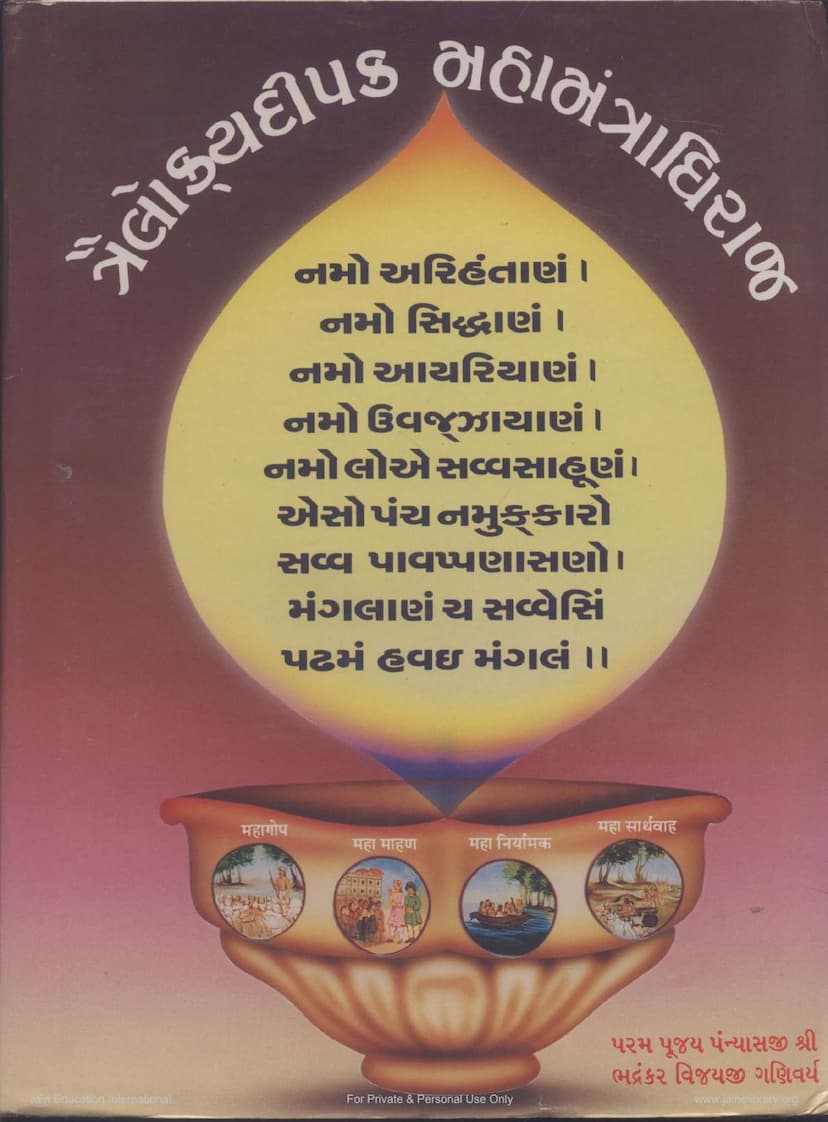Trailokyadipak Mahamantradhiraj
Added to library: September 2, 2025

Summary
The provided text is a Jain scripture titled "Trailokyadipak Mahamantradhiraj" by Bhadrankarvijay, published by Bhadrankar Prakashan. It is a comprehensive work dedicated to the profound significance and practice of the Namokar Mahamantra, also known as the Panch Parmeshthi Namaskar Mantra. The book delves into the spiritual, philosophical, and practical aspects of this central Jain mantra.
Here's a summary of the key themes and content based on the provided pages:
I. Exaltation of the Namokar Mahamantra and Reverence for the Author:
- Praise for the Author: The initial pages are dedicated to extolling the virtues of the author, Pujya Gyani Pt. Shri Bhadrakar Vijayji Maharaj Saheb. He is described with numerous superlatives, highlighting his mastery of scriptures, spiritual depth, adherence to Jain principles, compassion, and deep devotion to the Namokar mantra. He is referred to as an "Adhyatma Yogi," "Samata murti," "Vatsalya murti," and a beacon of peace and devotion.
- Significance of the Namokar Mantra: The book emphasizes that the Namokar Mahamantra is the essence of Jainism, a distillation of the fourteen Purvas, and a source of ultimate liberation. It is presented as an eternal and eternally potent mantra that has guided countless souls to self-welfare and liberation throughout history and will continue to do so in the future. The mantra's 68 letters and nine sacred syllables are considered profound, containing elements of friendship towards all beings, devotion to the divine, acceptance of the eternal, and detachment from the material world.
II. Philosophical Exposition of the Namokar Mantra:
- The Mantra's Components: The text breaks down the mantra, exploring the significance of each word and syllable. It touches upon the deeper meanings embedded within "Namo Arihantanam," "Namo Sidhanam," "Namo Ayariyanam," "Namo Uvajjhayanam," and "Namo Loye Savva Sadhunam."
- Nirvana and Eternal Truth: The mantra is presented as a path to understanding the eternal nature of the soul, its inherent purity, and its ultimate goal of liberation (Moksha). The concepts of soul-consciousness (Jivatattva) and supreme consciousness (Paramatma) are linked to the mantra's spiritual practice.
- The Power of Intent and Bhakti: The text stresses that the mantra's efficacy lies not just in its recitation but in the underlying intention and devotion (bhakti). It emphasizes the importance of right faith (Samyak Darshan), right knowledge (Samyak Gyana), and right conduct (Samyak Charitra) in realizing the mantra's true potential.
- Inner and Outer Practice: The book discusses both the external practice (like chanting and meditation) and the internal practice (cultivating virtues like compassion, non-violence, humility, and detachment) of the mantra, highlighting the supremacy of the inner devotional aspect.
- The Meaning of Namo: The word "Namo" itself is explored as a symbol of humility, surrender, and the recognition of a higher power. It represents the shedding of ego and the embrace of divine grace.
- Connection to Jain Principles: The text elaborates on how the mantra embodies core Jain tenets such as Ahimsa (non-violence), Samayik (equanimity), Brahmacharya (celibacy), and Tapasya (austerity).
III. Practical Aspects and Benefits:
- Purification and Well-being: The mantra is described as a purification process that cleanses the mind, body, and soul. Its practice is said to remove inner impurities, enhance mental clarity, and foster a sense of peace and well-being.
- Overcoming Obstacles: The mantra is believed to possess the power to overcome obstacles in life, remove negative karmic influences, and grant protection from worldly dangers.
- Spiritual Progress: Devotees who consistently practice the Namokar mantra are said to progress on the spiritual path, gaining virtues, deepening their understanding of the soul, and moving closer to liberation.
- Guidance and Support: The mantra is seen as a guiding light, a source of strength, and a constant companion in the spiritual journey, offering solace in difficult times and inspiration in spiritual pursuits.
- Holistic Approach: The book presents the Namokar mantra not merely as a religious chant but as a comprehensive spiritual discipline that impacts all aspects of life, leading to holistic growth and ultimate salvation.
IV. Historical and Scholarly Context:
- Authorship and Legacy: The book is a compilation or extensive exposition of the teachings of Pujya Gyani Pt. Shri Bhadrakar Vijayji, who was a renowned spiritual scholar and practitioner. The work itself seems to be a collection of his thoughts and writings on the Namokar mantra, possibly compiled by his disciples.
- Scholarly Analysis: The text references ancient Jain scriptures and commentaries, discussing philosophical concepts like Nayas (perspectives) and their application to understanding the mantra.
- The Author's Life: Pages are dedicated to the biographical details of Pujya Bhadrakar Vijayji, tracing his life from childhood to his spiritual journey and eventual renunciation, highlighting his deep connection and devotion to the Namokar mantra, which earned him the title "Navkarwala Maharaj." His passing away is described with deep reverence and sorrow.
V. Structure and Content:
The book is structured extensively, with a detailed table of contents (indicated by page numbers and topics) covering a vast array of subjects related to the Namokar mantra. This includes:
- Detailed explanations of each name (Nirdeś, Svāmitva, Hetu, etc.) related to the mantra.
- The origin and history of the mantra.
- The philosophical underpinnings of the mantra according to various Nayas.
- The practical benefits and Siddhis (supernatural powers) associated with its worship.
- Biographical sketches of the author and other revered figures.
- Discussions on related concepts like Dharma, Karma, Moksha, and the path to spiritual enlightenment.
- Numerous verses, quotes, and hymns in praise of the mantra.
- Discussions on the practical methods of chanting and meditation.
In essence, "Trailokyadipak Mahamantradhiraj" is an exhaustive treatise on the Namokar Mahamantra, aiming to provide the reader with a deep intellectual and spiritual understanding of its multifaceted significance, guiding them towards its sincere and effective practice for achieving ultimate well-being and liberation.